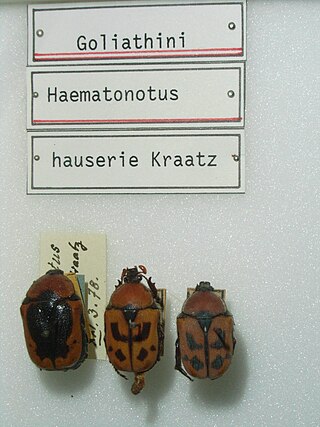
The family Scarabaeidae, as currently defined, consists of over 30,000 species of beetles worldwide; they are often called scarabs or scarab beetles. The classification of this family has undergone significant change in recent years. Several subfamilies have been elevated to family rank, and some reduced to lower ranks. The subfamilies listed in this article are in accordance with those in Bouchard (2011).

Trogidae, sometimes called hide beetles, is a family of beetles with a distinctive warty or bumpy appearance. Found worldwide, the family includes about 300 species contained in four or five genera.

Dynastinae or rhinoceros beetles are a subfamily of the scarab beetle family (Scarabaeidae). Other common names – some for particular groups of rhinoceros beetles – include Hercules beetles, unicorn beetles or horn beetles. Over 1500 species and 225 genera of rhinoceros beetles are known.

The Trichiini are a tribe of the scarab beetle family (Scarabaeidae), though historically they were often classified as a subfamily, Trichiinae. The conspicuous bee beetles (Trichius) are probably the best-known genus in Europe.

Flower chafers are a group of scarab beetles, comprising the subfamily Cetoniinae. Many species are diurnal and visit flowers for pollen and nectar, or to browse on the petals. Some species also feed on fruit. The group is also called fruit and flower chafers, flower beetles and flower scarabs. There are around 4,000 species, many of them still undescribed.

Goliathus orientalis is a species of beetles belonging to the family Scarabaeidae.

Melolonthinae is a subfamily of the scarab beetles. It is a very diverse group; distributed over most of the world, it contains over 11,000 species in over 750 genera. Some authors include the scarab subfamilies Euchirinae and Pachypodinae as tribes in the Melolonthinae.

Eupoecila australasiae, commonly known as the fiddler beetle or rose chafer, is a colourful green- or yellow-and-black member of the scarab beetle family from eastern Australia.

Scelophysa trimeni, commonly known as the blue monkey beetle, is a species of scarab beetles in the monkey beetle subfamily Rutelinae.

Cyclocephala is a genus of scarab beetles from the subfamily Dynastinae. Beetles of this genus occur from southeastern Canada to Argentina and the West Indies.
Cotinis subviolacea is a species of the Cotinis scarab genus. It was described by Hippolyte Louis Gory and Achille Rémy Percheron in 1833. It is found in the United States.

Rhabdotis albinigra is a species of Scarabaeidae, the dung beetle family. It was described by Hermann Burmeister in 1847.

Trichostetha is a genus of beetle in the scarab beetle family. It is endemic to southern Africa, and its species most commonly occur in mountainous terrain. The genus includes several species that have only recently been described, as well as many species lacking a description of any of the larval stages. Except for T. fascicularis and its subspecies, the species comprising Trichostetha have small ranges of distribution, frequently in the Cape Floral Region of South Africa.

Hoplopyga brasiliensis is a species of beetles of the family Scarabaeidae.

Inca is a genus of beetles belonging to the family Scarabaeidae.

Euphoria herbacea is a species of scarab beetle in Cetoniinae subfamily. It is 15–16 millimetres (0.59–0.63 in) long and is olive-green in color. It is endemic to the United States, especially to the Mississippi River.

Euphoria sepulcralis, the dark flower scarab, is a species of scarab beetle in the subfamily Cetoniinae. It is 9–11 millimetres (0.35–0.43 in) long and is brown in color. It is found in North America in countries such as Mexico and southern and Central United States.

Teuchestes fossor is a species of dung beetle native to the Palaearctic, but is also widespread in North America following accidental introduction and naturalisation during European settlement. Both adults and larvae are coprophagous, differentiating resource use by respectively feeding on the liquid and fibrous fractions of herbivore dung. It can be readily collected from the dung of livestock, and other large mammals This species is known to support a number of key ecosystem services in cattle pastures.

Rhinocoeta is a genus of colorful beetles belonging to the subfamily Cetoniinae, family Scarabaeidae.

Cetoniini is a tribe of fruit and flower chafers in the family of beetles known as Scarabaeidae. There are over 80 genera in Cetoniini.























